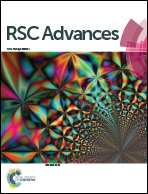Continuous polyacrylonitrile nanofiber yarns: preparation and dry-drawing treatment for carbon nanofiber production†
Abstract
Precursor fibers with diameters in nanometer scale and highly aligned polymer chains in fibers are highly promising for the preparation of high-performance carbon nanofibers, but are challenging to make. In this study, we demonstrate for the first time that a carbon nanofiber precursor can be prepared by the electrospinning of polyacrylonitrile into a nanofiber yarn and by the subsequent drawing treatment of the yarn in dry conditions. The yarn shows excellent drawing performance, which can be drawn evenly up to 6 times of its original length without breaking. The drawing treatment improves the yarn and fiber uniformity, polymer chain orientation within the fibers, as well as yarn tension and modules, but shows decreased yarn and fiber diameter and elongation at break. The drawing temperature and force show influences on the drawing behavior. The highest strength and modules (362 ± 37 MPa and 9.2 ± 1.4 GPa, respectively) are found on the yarn drawn by 5 times its length, which increased by 800% and 1800% when compared to the as-spun yarn. Through un-optimized stabilization and carbonization treatments, we further demonstrate that the carbonized nanofiber yarn shows comparable tensile properties as the commercial carbon fibers. Electrospun nanofiber yarns may form next generation precursors for making high performance carbon fibers.


 Please wait while we load your content...
Please wait while we load your content...